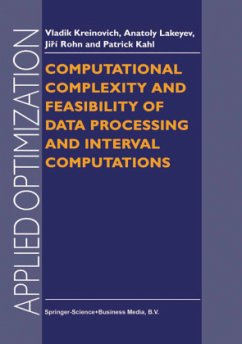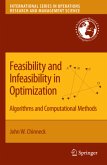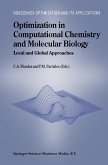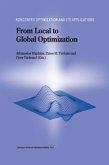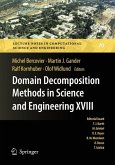The input data for data processing algorithms come from measurements and are hence not precise. We therefore need to estimate the accuracy of the results of data processing. It turns out that even for the simplest data processing algorithms, this problem is, in general, intractable. This book describes for what classes of problems interval computations (i.e. data processing with automatic results verification) are feasible, and when they are intractable.
This knowledge is important, e.g. for algorithm developers, because it will enable them to concentrate on the classes of problems for which general algorithms are possible.
Targeted audience - Specialists in numerical computations, especially in numerical optimiza tion, who are interested in designing algorithms with automatie result ver ification, and who would therefore be interested in knowing how general their algorithms caIi in principle be. - Mathematicians and computer scientists who are interested in the theory 0/ computing and computational complexity, especially computational com plexity of numerical computations. - Students in applied mathematics and computer science who are interested in computational complexity of different numerical methods and in learning general techniques for estimating this computational complexity. The book is written with all explanations and definitions added, so that it can be used as a graduate level textbook. What this book .is about Data processing. In many real-life situations, we are interested in the value of a physical quantity y that is diflicult (or even impossible) to measure directly. For example, itis impossible to directly measure the amount of oil in an oil field or a distance to a star. Since we cannot measure such quantities directly, we measure them indirectly, by measuring some other quantities Xi and using the known relation between y and Xi'S to reconstruct y. The algorithm that transforms the results Xi of measuring Xi into an estimate fj for y is called data processing.
This knowledge is important, e.g. for algorithm developers, because it will enable them to concentrate on the classes of problems for which general algorithms are possible.
Targeted audience - Specialists in numerical computations, especially in numerical optimiza tion, who are interested in designing algorithms with automatie result ver ification, and who would therefore be interested in knowing how general their algorithms caIi in principle be. - Mathematicians and computer scientists who are interested in the theory 0/ computing and computational complexity, especially computational com plexity of numerical computations. - Students in applied mathematics and computer science who are interested in computational complexity of different numerical methods and in learning general techniques for estimating this computational complexity. The book is written with all explanations and definitions added, so that it can be used as a graduate level textbook. What this book .is about Data processing. In many real-life situations, we are interested in the value of a physical quantity y that is diflicult (or even impossible) to measure directly. For example, itis impossible to directly measure the amount of oil in an oil field or a distance to a star. Since we cannot measure such quantities directly, we measure them indirectly, by measuring some other quantities Xi and using the known relation between y and Xi'S to reconstruct y. The algorithm that transforms the results Xi of measuring Xi into an estimate fj for y is called data processing.
`The book is very well organized. The book is readable, very detailed, and intelligible. Moreover, it is exciting and gripping because the reader is often surprised by unexpected results. Everyone who is interested in modern aspects of numerical computation will enjoy reading this interesting and informative work. The book is a must for everyone who is doing research in this field.'
Mathematical Reviews, 98m
Mathematical Reviews, 98m
`The book is very well organized. The book is readable, very detailed, and intelligible. Moreover, it is exciting and gripping because the reader is often surprised by unexpected results. Everyone who is interested in modern aspects of numerical computation will enjoy reading this interesting and informative work. The book is a must for everyone who is doing research in this field.' Mathematical Reviews, 98m

